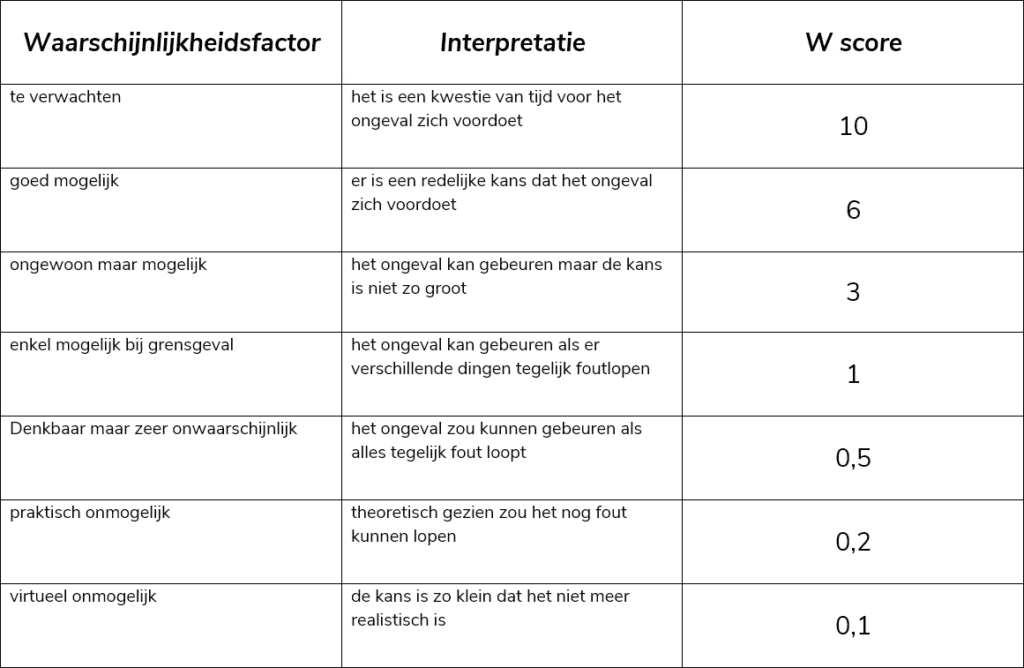Opmaak van een taakrisicoanalyse (TRA)
Een gedetailleerde risico inschatting van een specifieke taak.

Een taak risico analyse (TRA) start bij het inventariseren van risico's.
Inhoudsopgave
Welke factoren bepalen de extra risico's van een opdracht?
- De aard van het werk: Werken met gevaarlijke stoffen, graafwerkzaamheden, hogedrukvloeistofreiniging, nieuwe machines...
- De werkplek: Besloten ruimte, moeilijk toegankelijke werkplek, weinig vluchtwegen, weinig bewegingsruimte...
- De werkplekomgeving: Verkeer, materiaalopslag, andere activiteiten in de buurt, werken in een productieruimte...
- Complexiteit van het werk: Met meerdere bedrijven op dezelfde plek actief, tijdsdruk, veel personen op een kleine plek...
- Werkcondities: Uitzonderlijke weersomstandigheden, verlichting, geluid, temperatuur, stof, stank, trillingen, werkhouding...
Het kan gebeuren dat de taak risicoanalyse (TRA) tijdens de werkzaamheden wordt bijgesteld. Dit kan gebeuren wanneer het voorgestelde werkplan in de praktijk niet uitvoerbaar blijkt te zijn, het juiste gereedschap ontbreekt, de werkcondities zijn veranderd, of er net een ongeval of incident heeft plaatsgevonden.
Wie stelt de TRA op?
De taakrisicoanalyse wordt opgesteld door een team van uitvoerders, planners, werkvoorbereiders en eventueel deskundigen. De opdrachtgever die de werkvergunning uitschrijft, kan ook eisen dat er een TRA wordt opgesteld. Je kan ook zelf bepalen dat de werkzaamheden ongewoon zijn en spontaan een TRA op te stellen.
Waar moet je op letten?
- Veiligheid: Het voorkomen van ongevallen, fouten en onveilige situaties.
- Gezondheid: Het voorkomen van gezondheidsschade.
- Milieu: Het minimaliseren van invloeden van de omgeving.
- Efficiëntie: Doelgericht werken tegen minimale kosten.
- Welzijn: Het creëren van een zo gunstig mogelijk werkklimaat.
Een TRA wordt specifiek opgemaakt bij afwijkende werken. Besteed voldoende aandacht aan de specifieke eigenschappen die het werk afwijkend maken en mogelijk ook meer risicovol.
opstellen van een TRA?
Van planning naar uitvoering in 8 stappen
Stap 1 - Stel de taak vast
Bepaal in detail wat ‘anders’ is dan de ‘normale’ werkzaamheden.
- Wat is de aard van het werk?
- Hoe zijn de arbeidsomstandigheden?
- Is de omgeving anders?.
- Hoe complex is het werk?
- Onder welke condities moet het werk worden uitgevoerd?
Stap 2 - Bepaal de risico's
Bepaal en inventariseer de risico’s. Kijk niet alleen naar de aanwezige risico’s, maar houd ook rekening met nieuwe risico’s die kunnen ontstaan.
Gebruik hierbij het risico analyse model van Fine & Kinney:
R = W x B x E
Risico = waarschijnlijkheidsfactor x blootstellingsfactor x ernstgraad

De waarschijnlijkheidsfactor W is de kans dat een gevaar schade veroorzaakt.

De blootstellingsfactor B houdt rekening met de duur en de frequentie van de blootstelling aan het gevaar.

Bij de ernstgraad E geef je aan wat de mogelijke en meest ernstige effecten zijn van de blootstelling.

Het uiteindelijk risicocijfer geeft een duidelijk zicht op de aanvaardbaarheid van het risico.
Stap 3 - Neem risico’s weg of maak ze beheersbaar
Elimineer risico’s systematisch, maar zorg ervoor dat de praktische uitvoerbaarheid van het werk niet in het gedrang komt.
Stap 4 - Analyseer en beschrijf de werkvoorbereiding
Houd vooral rekening met de volgorde van de werkzaamheden, deze zijn van cruciaal belang bij een taak risico analyse. Voor bepaalde taken kan het namelijk zeer gevaarlijk zijn om de stappen in een verkeerde volgorde uit te voeren. Denk bijvoorbeeld aan het uitschakelen van een stroomcircuit, het verwijderen van de druk uit een hydraulieksysteem, of het plaatsen van waarschuwingen bij het openen van een toegangsluik.
Besteed ook voldoende aandacht aan andere factoren en vereisten, zoals de te volgen procedures, de aanwezigheid en veiligheid van machines / werktuigen, eventuele opleidings- en ervaringsvereisten van de uitvoerders, en de te hanteren tekeningen en kwaliteitseisen, die worden gesteld door jezelf of de opdrachtgever.
Stap 5 - Stel de taak risicoanalyse op met het team
Maak een risicoanalyse op met verschillende werknemers met diverse expertise. Betrokkenheid van alle uitvoerenden, planners en werkvoorbereiders is cruciaal voor een brede analyse van mogelijke risico’s.
Stap 6 - Communiceer de taak risicoanalyse naar de betrokken partijen
Communiceer de voltooide taak risicoanalyse naar alle betrokkenen, inclusief uitvoerenden en leidinggevenden. Een kick-offmeeting voor de werkzaamheden is ideaal om de TRA te bespreken.
Stap 7 - Voer de werken uit volgens de maatregelen
Start het werk nadat iedereen op de hoogte is van de beheersmaatregelen. Doeltreffende communicatie vooraf zorgt voor veiligere werkomstandigheden.
Een schriftelijk document kan dienen als nuttige referentiebron. Het is de verantwoordelijkheid van de werknemer om de werkzaamheden uit te voeren in overeenstemming met de veiligheidsvoorschriften en ervoor te zorgen dat hij geen gevaar vormt voor zowel zichzelf als zijn collega’s.
Tijdens de uitvoering van de werkzaamheden dienen leidinggevenden nauwlettend toe te zien op de risico’s die zijn geïdentificeerd in de TRA.
Stap 8 - Evalueer en documenteer de resultaten
Na beëindiging van de taak / project volgt een evaluatie met de betrokkenen, inclusief uitvoerenden, werkvoorbereiders, planners en leidinggevenden. Bespreek of het werk conform veiligheidsvoorschriften en werkinstructies is uitgevoerd. Bespreek eventuele onvoorziene omstandigheden, gevaarlijke situaties of ongevallen.
Bewaar de taak risico analyse op een centrale locatie, zelfs indien je ze niet onmiddellijk opnieuw nodig hebt. Het verslag en de evaluatie van de TRA dienen zorgvuldig te worden bewaard, aangezien deze informatie in de toekomst waardevol kan zijn als inspiratiebron bij vergelijkbare werkomstandigheden.
Besluit
- De conventionele risicoanalyse wordt aangevuld met een TRA om uitzonderlijke werkzaamheden veilig aan te pakken.
- Een TRA wordt vóór aanvang opgesteld door het betrokken team, waardoor extra risico’s volledig worden belicht.
- Communiceer de TRA met alle betrokkenen om risicofactoren te minimaliseren en zorg voor een zorgvuldige documentatie van het proces.
- Het opstellen van een TRA is een cruciale stap om te waarborgen dat uitzonderlijke werken veilig en doeltreffend worden uitgevoerd.
Prevom kan je helpen bij het opstellen van een taak risicoanalyse. Onze consultants geven advies en staan je bij met hun expertise.
Op zoek naar duidelijkheid?
Wie moet er een TRA opmaken? Wat is afwijkend werk nu precies? Hoe lang op voorhand kan ik een TRA maken? Kan ik dezelfde TRA hergebruiken? Hoe ziet een taak risico analyse model eruit?
Prevom heeft de expertise die je zoekt.
Wij informeren je graag over de mogelijkheden!